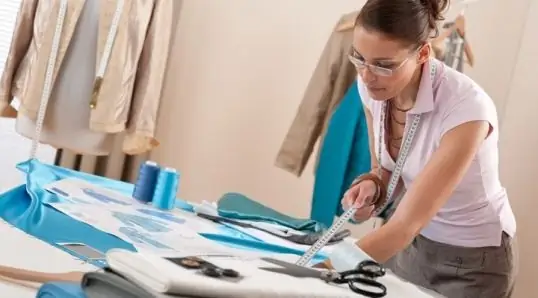When you start sewing a coat that you decide to make with your own hands, you must carefully select the fabric and prepare it for the cutting procedure. Compliance with simple rules will allow you to correctly cut the material and save you from mistakes, which may well have a negative effect on the quality of the finished product.

The first rule states that it is necessary to use only that fabric that does not have significant defects for cutting a coat. Carefully examine the material selected for sewing. Make sure there are no obvious holes, holes, discoloration or unnecessarily thick threads. Identified defects should be marked with colored thread or chalk. This will allow you to place problem areas of fabric in places that will not be visible on the finished coat, for example, on the lower collar or hem.
The second rule of cutting: before direct cutting, the fabric must be decated. We are talking about wet-heat treatment of the material, which eliminates shrinkage of the fabric during sewing and while wearing a coat. In ordinary household conditions, an iron is used for decorating, but if you have to sew a lot, it makes sense to purchase a special device called a steam generator.
To design a fabric containing chemical fibers, soak it in water, wring it out a little, and then wrap it in a clean, dry sheet. In this position, the material should lie down for at least three hours. Now you can unfold it and iron it with an iron from the wrong side. It is recommended not to soak the woolen fabric, cashmere and drape, often used for sewing coats, but to iron it from the inside out through a slightly damp cotton rag. The lining material should also be rolled.
When decating, the iron should move in the direction in which the share thread is located.
If you are doing custom tailoring, it is convenient to fold the fabric in half lengthwise with the right side facing inward. In this case, the pattern is performed only for half of the product (one sleeve, half of the front, half of the back, and so on). If the fabric of your choice has an intricate pattern that requires fitting, lay it face down in one layer. The number of patterns for this case will correspond to the number of coat details.
The following cut rule: when laying out patterns on the fabric, be sure to take into account the location of the warp threads, the nature of the pattern and the pile. On the main details of the coat, the threads should be in the lobe direction. This is a very important point, since this way the finished product will stretch less when worn and will not lose its original shape.
You should be aware that the warp threads are usually directed along the edge of the material.
Another rule concerns the alignment of patterns and designs in the space of the future product. The coat must be cut with great care if the fabric has a floral or large geometric pattern. When laying out patterns on the material, make sure that the middle of the parts and the centers of the patterns are exactly aligned with each other. Pay particular attention to the symmetry of the patterns on the details of the coat located on the right and left sides of the garment.
It is recommended to start cutting the coat from the back. To do this, it is convenient to draw a rectangle that has a quarter of the chest circumference. The length of this piece should match the coat length you choose. A line of the waist and chest is marked on a rectangle, as well as the neck of the coat and the armhole of the sleeves. The shelf is cut out in the same way as the back, leaving a sufficient margin for the fastener on it.
When cutting, do not forget to leave a seam allowance of 2-3 cm. The allowance for hemming the bottom of the coat should be larger - 4-5 cm.
The coat sleeve is traditionally drawn on the basis of two perpendicular lines, marking the width and length of this part. At the bottom, the sleeve pattern can be made narrower, taking into account the width of the wrist. Depending on the cut, you may also need to cut out pockets, belts, collars and yokes. At the last stage of the work, it is necessary to repeat all the elements of the sleeves, backs and shelves on the fabric that will go to the lining.






